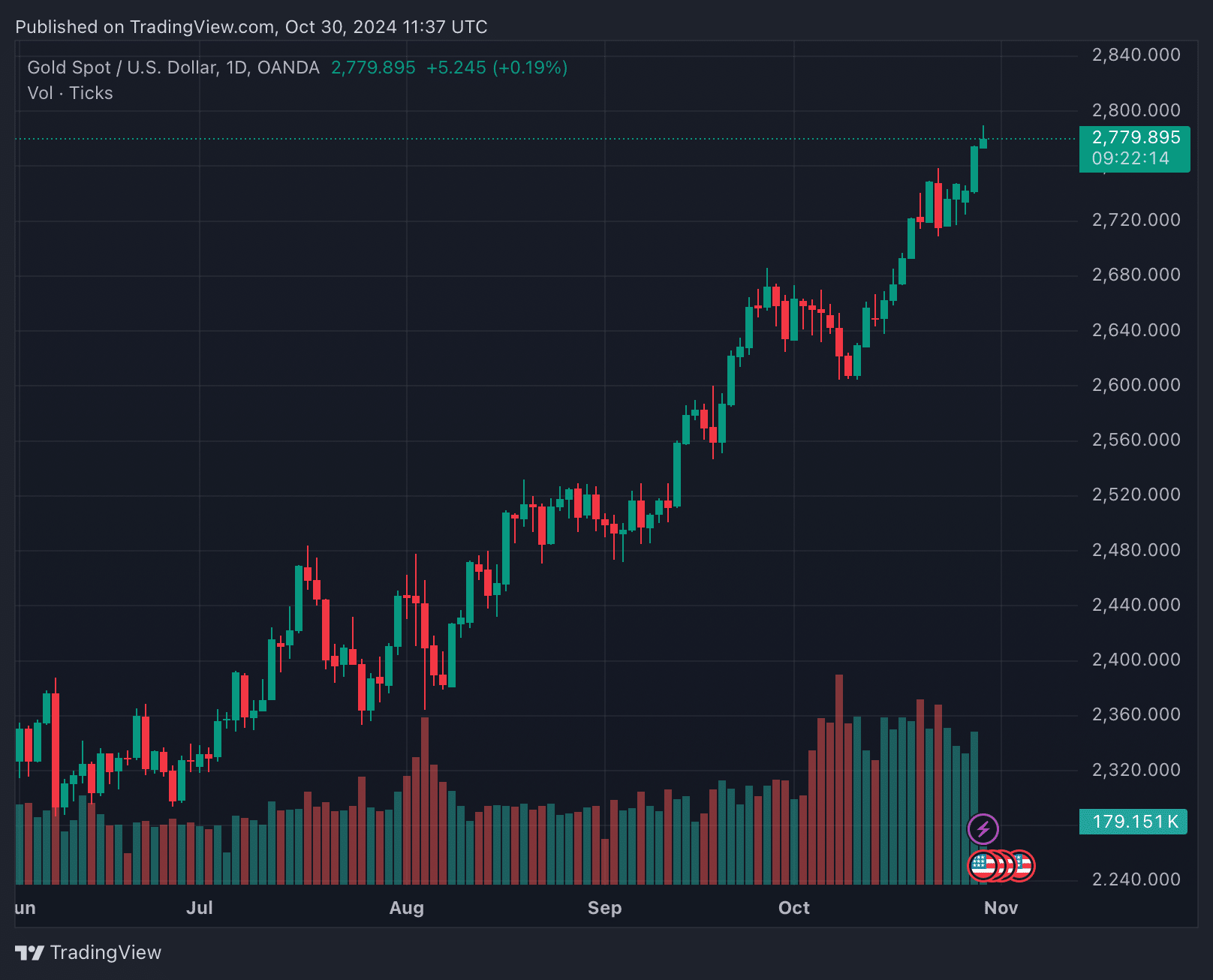With gold and Bitcoin both at or near record highs, the debate over which is better ‘hard money’ is heating up as investors seek hedges against economic uncertainty, inflation, and geopolitical change.
Table of Contents
In a time of mounting economic pressures, two traditionally opposed assets — gold and Bitcoin — are surging at or near their all-time highs, stirring debate about their roles as “hard money.” As gold pushes past the $2,770 mark and Bitcoin (BTC) hovers close to its all-time high of $73,800, the simultaneous rallies hint at underlying market anxieties. Investors are increasingly eyeing both as defensive hedges against economic volatility, casting a spotlight on the debate over which asset better holds its value.

The need for understanding the hard money debate is essential, especially in uncertain times, with the US election in a neck-and-neck race; questions have arisen as to which asset is a better hedge against potential economic instability, inflation, and geopolitical shifts that could impact traditional markets.
Over the past year, gold has risen by over 38%, while at the same time, Bitcoin has risen a shade by over 115%. These peaks have drawn commentary from various investors on both sides of the hard money debate, including Chamath Palihapitiya, Larry Fink, and Peter Schiff.
According to Palihapitiya, “Bitcoin is going to be the resounding inflation hedge asset for the next 50 to 100 years,” he said on a recent podcast.
“You’re seeing the last vestiges of people using gold as a rational economic insurance policy.”
But gold’s latest peak has also drawn commentary from prominent advocates, such as notorious metal money advocate Peter Schiff, who shared on X: “Gold closed at a record high above $2,755, on track for its best year since 1979.”
”The difference is that in 1979, inflation was near its peak and the gold bull market was near its end, whereas now, inflation is near its trough and the gold bull market is just getting started.”
Bullish sentiments on precious metals, others are more nuanced in their views of what hard money looks like in the 21st century.
“The role of crypto is digitalizing gold,” said Larry Fink, CEO of BlackRock on a recent Fox Business segment. “We hope regulators look at the Spot ETF filings as a way to democratize crypto,” the world’s leading asset manager stated.
Bitcoin: ‘digital gold,’ store of value or medium of exchange?
Unlike gold, however, Bitcoin lacks a centuries-long track record and has faced bouts of extreme volatility that can pose challenges for those seeking stability. Still, with Bitcoin nearing its all-time high, interest in its potential as “digital gold” continues to grow, especially among younger and tech-savvy investors who value its portability and ease of transfer.
The term “digital code” is often associated with the development of computer science and digital information theory, but it does not have a single, universally acknowledged inventor. However, one of the earliest and most influential figures in the conceptualization of digital information is Claude Shannon. Shannon, in his groundbreaking 1948 paper “A Mathematical Theory of Communication,” laid the foundation for digital encoding and information theory, which helped shape the concept of digital code, Bitcoin, and the idea that hard money could be encoded via blockchain technology, encryption and a cap on supply.
Are these rallies an early warning sign?
The rise in both gold and Bitcoin could be more than a reflection of individual market dynamics; it may signal a growing unease with the broader economy.
Historically, sharp moves in these assets have often preceded economic downturns as investors seek refuge from anticipated turbulence. This pattern, as observed in the early 1970s and during the 2008 financial crisis, could suggest that today’s price surges are signaling a lack of confidence in traditional financial markets.
Academic research supports this thesis. Research by Bouri et al. (2017) notes that Bitcoin can serve as “a hedge similar to gold, particularly in response to currency devaluation and macroeconomic uncertainty.” This is echoed by Ratner and Chiu (2013), who observed that “investors often flock to assets perceived as safer, including precious metals and alternative assets like Bitcoin,” especially during periods of financial crisis. Reboredo (2013) further supports this thesis by highlighting the stability of precious metals like gold, stating that macroeconomic events and financial crises “drive investors to seek stability in gold,” reinforcing its role as a safe haven.
Indeed, gold’s supply grows incrementally through mining, with physical constraints that have kept its value stable over time. Bitcoin, however, operates on a fixed, coded supply cap of 21 million coins, which is expected to be reached by 2140. This programmed scarcity, combined with Bitcoin’s halving events (which reduce the reward for miners every four years), has reinforced a deflationary view of the asset.
The hard money debate into 2025
As both gold and Bitcoin continue to rally, investors are left with a critical choice: a traditional asset that has long served as a safe haven or a newer, digital alternative with distinct advantages in portability and scarcity. The debate over which is the better “hard money” has yet to be settled, but one thing is clear—both assets are resonating with a growing audience that values stability in uncertain times. Whether the economy’s direction will validate this defensive positioning remains to be seen, but if history is any guide, gold, and Bitcoin may once again serve as early indicators of shifts on the horizon. Just don’t mention Ethereum.
Disclosure: This article does not represent investment advice. The content and materials featured on this page are for educational purposes only.
This article first appeared at crypto.news

